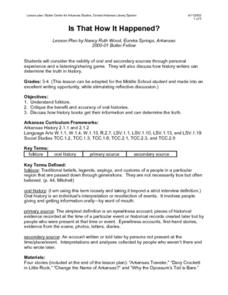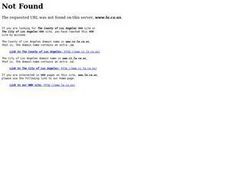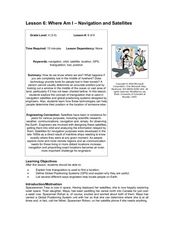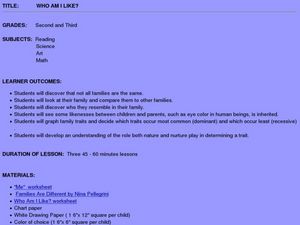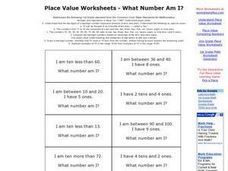Penguin Books
A Teacher's Guide to The Omnivore’s Dilemma: A Natural History of Four Meals by Michael Pollan
"What should we have for dinner?" "What am I eating?" "Where did it come from?" These three questions are at the heart of Michael Pollan's The Omnivore's Dilemma: A Natural History of Four Meals. Pollan's book provides some very...
Global Oneness Project
The Value of Sports: Unifying a Community
The Global Oneness Project presents a lesson about the power of sport to bring a community together. After watching the documentary film, I am Yup'ik, class members use the provided discussion questions to reflect on the importance of...
Curated OER
Anna Grammar Worksheet - Yes/No Questions
For this grammar worksheet, students fill in 10 sentences with the correct word - am, are or is. They correct 8 sentences by putting the words in order.
Curated OER
Frog and Toad Are Friends
Second graders complete pre reading, writing, during reading, and interdisciplinary activities for the book Frog and Toad are Friends. In this reading lesson plan, 2nd graders complete journal entries, go over vocabulary, answer short...
Curated OER
Are or Our?
Are and our are two of the most commonly misused words in the English language. This presentation tries to address that fact. And it does! The different uses of these two words is clearly explained. A clever slide closes the PowerPoint.
Curated OER
Student Opinion: Are You Popular, Quirky or Conformist?
Approach the topic of popularity with this resource from the New York Times and their Learning Network series. The article is about Alexandra Robbins' "Quirk Theory." Learners respond to the article excerpt either on paper or online....
Curated OER
Where the Books Are
The news is full of interesting stories and ideas shared in an informational style. Readers use the provided who, what, when, where, and why questions as they explore an article about a man who is passionate about archiving physical...
Curated OER
When Is It O.K. to Replace Human Limbs With Technology?
Today's blog topic is robotic limb replacement for amputees. Upper graders read the related article and argument, then compose a blog response that addresses the questions provided. This is a great way to get kids thinking about ethics,...
Curated OER
Are Antismoking Ads Effective?
Are the anti-smoking ads put out by the federal government effective? This question is posed to your critical thinkers. They'll read excerpts from a New York Times article and then compose thoughtful blog responses to four related...
Curated OER
Is Modern Culture Ruining Childhood?
There are a lot of different ways a learner could respond to this New York Times article discussing the effects of modern culture on childhood. After reading the article, pupils construct a thoughtful blog post. The guiding questions...
Curated OER
Is It Ethical to Eat Meat?
Have your class join a blog about whether or not eating meat is good for you. They'll read several passages regarding meat processing and consumption, then they post what they think. There are six critical-thinking prompts to help them...
Curated OER
Student Opinion: How Impulsive Are You?
Sure to spark lively discussion in any Language Arts classroom, this article from The York Times asks the question, 'How much self-control do you have?'. Pupils begin by reading a short passage about a study on delayed gratification and...
Curated OER
Is That How it Happened?
Younsters are exposed to classic stories of Arkansas Folklore including The Arkansas Traveller, and Davy Crockett. They discuss if the stories they hear are examples of folklore, or some other kind of story. Then, each puil is required...
Curated OER
When is a Noun a Verb? Examining Double Duty Words
Act and act, address and address...there are so many words in our dictionary that can function as nouns or verbs. Start this lesson by having your class list as many as they possibly can. When an adequate list presents itself, have your...
Curated OER
What am I?
In this animal related worksheet, students read and analyze each clue card to figure out what animal is being described and check their answers against the answer key.
Curated OER
What Shape am I?
Young scholars analyze characteristics of geometric shapes. They find shapes in their environment, and communicate why it is like the shape of their choice and not like another shape.
Curated OER
Famous Person - Who Am I?
Students have an important historical figure on a card on their back and by giving them clues, students have to determine who they are. In this historical figure lesson plan, students compete to find out who they are first.
Curated OER
Who am I and Why?
Students make comparisons about themselves and others, which are real and meaningful. They study some basic concepts in the area of genetics and do a complimentary series of experiments, or explorations that illustrate these concepts
Curated OER
Where Am I: Navigation and Satellites
Students explore the concept of triangulation that is used in navigation satellites and global positioning systems designed by engineers. They determine ways these technologies can help people determine their position or the location of...
Curated OER
Where Am I: How to Read a Map
Third graders develop an understanding of maps. They explore what a map is, who uses maps, and how to use maps. Students investigate the compas rose. They create a compose rose which illustrates the cardinal directions. Students practice...
Curated OER
Who Am I Like?
Young scholars examine family structures. In this family structure activity, students discover things about their own families and those of their classmates. They make a chart as they discuss nature versus nurture, complete a worksheet...
Curated OER
Hello, I Am Deborah Sampson
Fifth graders research a historical figure from the Revolutionary War, dress as that person, and present information on that person. In this Revolutionary War lesson plan, 5th graders are videotaped as they present to the class.
Curated OER
Who Am I? the Web of Life ... With a Twist!
Students are assigned a secret species identity. They identify with the help of the other players. Once all identities have been deciphered, players form a circle and, by passing a ball of yarn from "species to species", they form...
Worksheets Plus
Place Value Worksheets - What Number Am I?
Practice place value with this resource. The 12 questions consist of riddles. For example, "I have 4 tens and 2 ones. What number am I?" This is a creative approach to thinking about double-digit numbers. Answers are available so you can...














